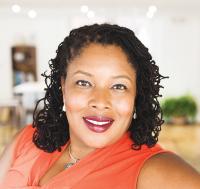Dr. First: Jami Valentine Miller
Spring
2019
Feature
Dr. First: Jami Valentine Miller
Rachel Kaufman, Editor
Thanks to her work founding African American Women in Physics, other “firsts” may feel a little less lonely.
Miller was born in Philadelphia, where she realized her aptitude for math at an early age. This led her to a middle school magnet school for math and to a high school program that gave her college prep over the summer.
After those experiences, “I knew I was going to major in a science or engineering field,” Miller said. “It felt completely natural. It didn’t feel at all odd to be a black girl in Philadelphia who wanted to [do that].”
At a college fair at her high school, she was recruited to a historically black college and university (HBCU), Florida A&M University, where she earned a BS in physics. At the time, FAMU didn’t have a graduate program in physics, so she went to Brown for her master’s, then Johns Hopkins for her PhD.
“One of the things HBCUs do is they prepare you for life in the real world,” Miller said. “In the real world, you’re not going to be in a situation that’s 95% minority. [At Brown], I made friends, I socialized. It was definitely a culture shock because Tallahassee is not Providence. . . . It was different, but I was prepared.”
Fast-forward seven years, and Miller was just finishing her dissertation in materials for spintronic applications.
“I always wanted to do something more on the applied side. When I got to Hopkins, one of the labs that piqued my interest was with C. L. Chien.” His lab, which focused on magnetic materials and applications, had recently developed a method of using point-contact Andreev reflection to determine whether a material can retain electron spin information. Miller set to work using that method to examine whether dysprosium or gadolinium could do so. If so, those elements could be used in magnetic tunnel junction devices, which could someday replace silicon in computers, making our phones, laptops, and hard drives smaller and cheaper.
She had almost finished when her advisor insisted she get a job lined up before defending. She applied to as many positions as possible—and heard back from the US Patent and Trademark Office.
“It was eight months of paid training. I was like, ‘I’ll take this job while I wait to hear back from my true passion—a postdoctoral position.’” But patent examining turned out to be Miller’s dream job, and she’s still there, examining patents for semiconductor devices. “I enjoy the work, [and] it’s related to my dissertation.”
At the same time she was finishing her dissertation, Miller became acutely aware of how few other black women she knew in physics, and she started an Excel spreadsheet to track the few she knew of.
“At the time there were less than 50. I’d meet these women at different conferences [and track] who they were, what were their careers. I posted it on my website at Hopkins.” That Excel sheet eventually grew into African American Women in Physics (http://aawip.com/), a site to celebrate African American women “who are doing amazing things,” Miller says. “It’s also a safe space where people can discuss their concerns or any situations they might be in, because most people are going to be the only African American woman—possibly the only African American or the only woman [in their program].”
The women trade advice on navigating careers and “talk about what it’s like to be the first” African American woman in their program. “If you didn’t go to Stanford or Howard, you were probably going to be the first,” Miller says.
Now, Miller is celebrating the accomplishments of these women while also showing that physics is central to everything. At PhysCon, when she returns to the city where she got her master’s, she’ll discuss how physics and intellectual property are related.
“I’m biased,” she says, “but everything is physics. If you want to be an electrical engineer, all you have to do is figure out the vocabulary . . . because they’re still doing physics, they’re just calling it something slightly different. . . . Even if you’re just [building a] table, a table has to be balanced. There’s physics in there. If you’re interested in it, go for it.”

